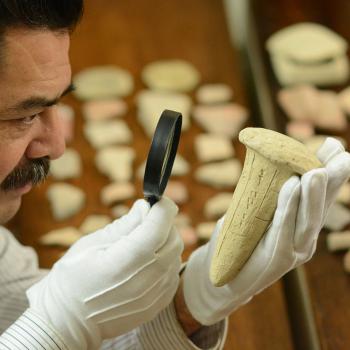
Today is Good Friday, which recounts Jesus’ suffering and death on the cross. I cannot imagine the depths of pain Jesus experienced. Nor can I really comprehend the pain many people throughout the world experience today, including the pain my family and I endure.
I have been thinking a lot about pain the past several days in view of Jesus’ passion on Good Friday and my son Christopher’s ongoing suffering resulting from his traumatic brain injury. It has led me to recall a couple of conversations about pain with Dr. Potter, our family medical consultant.
We were talking about the likelihood of Christopher experiencing severe pain, some of which may be associated with severe spasticity and contractions resulting from his traumatic brain injury. Without in any way minimizing the problem of pain, Dr. Potter encouraged me to consider the following: any experience of pain signifies that Christopher is alive and conscious. A corpse does not experience pain. Someone who is not conscious does not experience pain either.
Dr. Potter was quick to qualify. Efforts must be made to manage the pain if it impacts one’s quality of life. After all, not all pain is gain. But pain can be good or serve good ends if we seek to address the cause of suffering.
Speaking of addressing the cause of suffering, a pain doctor has recommended a baclofen pump implantation. What is that? According to the University of Rochester Medical Center, “Baclofen pump implantation is a surgical procedure performed to permanently implant a pump that delivers baclofen to the spinal fluid to treat severe to moderate-severe spasticity that is refractory to oral medications. It continuously delivers baclofen in small doses directly to the spinal fluid, increasing the therapeutic benefits, and causing fewer and less severe side effects compared to the oral medicine.” The hope is that the baclofen pump implantation will serve to reduce spasticity and contractions wherever it is needed in Christopher’s body, which may also serve to reduce pain. We are now waiting clearance for the medical personnel to begin the procedures.
I am eager to see if the doctor will gain clearance for the procedure and to discern what difference the baclofen pump might make. So, I called and spoke with his nurse yesterday to find out how the process if going. After we discussed the process, I joked with the nurse and said “I wish they could insert a baclofen pump in me, too.” I added: “Sometimes you have to laugh to keep from crying.” I have experienced my fair share of emotional spasticity and contractures ever since Christopher’s injury in January 2021. About the only resource I have at times to contend with the spasticity is my poor attempt at humor.
There’s nothing funny about Good Friday or Christopher’s traumatic brain injury. Nor is there anything funny about the pain Jesus, Christopher, and the rest of us experience. And yet, I am thankful that Jesus experienced and endured pain and that Christopher and the rest of us do, too.
Pain can serve good ends if we account for it. Pain can be instrumental in fostering hope and healing. The fact that we experience pain means that hope is not lost. We are alive and conscious. One wonders, though, how alive and conscious we are if we airbrush our existence, brush aside pain, and never account honestly for suffering. Pain can be a warning that not all is well and that we must address pressing problems. We must approach pain purposelessly, not allowing it to overwhelm us, but to make us alert to problems that we must address in pursuit of a meaningful quality of life.
If we are attentive, we will allow pain to instruct us so that we will pursue healing. In Jesus’ case, the hurt he experienced led to healing. According to the Christian faith, Jesus’ suffering and death on the cross was not meaningless, but purposeful. Jesus suffered and died and rose again to heal people’s severed relationships with God and with one another and our world at large. The New Testament highlights Isaiah 53 and applies it to Jesus’ healing of people relationally. Here’s Isaiah 53:5 and 1 Peter 2:23-25:
“But he was pierced for our transgressions, he was crushed for our iniquities; the punishment that brought us peace was on him, and by his wounds we are healed” (Isaiah 53:5; NIV).
“When they hurled their insults at him, he did not retaliate; when he suffered, he made no threats. Instead, he entrusted himself to him who judges justly. ‘He himself bore our sins’ in his body on the cross, so that we might die to sins and live for righteousness; ‘by his wounds you have been healed.’ For ‘you were like sheep going astray,’ but now you have returned to the Shepherd and Overseer of your souls.” (1 Peter 2:23-25; NIV)
In view of Jesus’ hopeful and purposeful approach to pain whereby his stripes we are healed, how might I approach our family’s present ordeal? I must not allow pain to get the best of me, leave me at my worst, and lead me to despair. Nor must I discount or brush pain aside. I must consider how I can take action in Christopher’s painful situation to provide the necessary support so that he might experience healing from his own stripes and a meaningful quality of life. Christopher’s alive. He’s conscious! I am, too.
God has not given me a Hallmark card life. But I dare not airbrush my existence. Otherwise, I will never grow through pain.
Pain is real, not an illusion, like Nine Inch Nails’ impactful song “Hurt,” which made an even more indelible impression on me through Johnny Cash’s cover. I love how Cash’s video recording of the song weaves his trying experiences together with Jesus’ pain and suffering. For all the agony, for all the apparent sense of isolation and abandonment in Cash’s version, I come away with a sense of hope. Cash is not alone. We are not alone. Jesus suffers with us. He suffers to remove the isolation and bring relational healing to us all.
How are you and I going to make the most of our suffering and turn the pain into gain? How might we approach painful relationships and circumstances? I am going to approach Christopher’s pain, and my pain, with an awareness that the pain informs us we are alive and that we experience some level of consciousness. I am going to continue to approach the pain purposefully and do whatever I can in support of Christopher because I love him and so that he and I might experience some form of meaningful recovery from this ordeal. This enduring realization of good, purposeful pain will serve me well as I go to visit my son today on Good Friday and on other days and nights that are not so good.
















